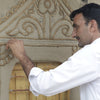![]() Get Upto 10% OFF on purchase of this product.
Get Upto 10% OFF on purchase of this product.
![]() Get upto 10% OFF on Live Workshops when sign up for 2 or more workshops.
Get upto 10% OFF on Live Workshops when sign up for 2 or more workshops.
![]() Get 10% OFF coupon code for Art Kits signing up for Masterclass or Live Workshop.
Get 10% OFF coupon code for Art Kits signing up for Masterclass or Live Workshop.
![]() Earn upto 3,000.00 Points on purchase of this product.
Earn upto 3,000.00 Points on purchase of this product.
ONLINE LIPPAN KAAM / MUDWORK WORKSHOP BY NALEMITHA
This workshop is now over, you can buy recordings.
This workshop was done in 2 classes and thus 2 recordings would be provided. It was a two hour class for beginners and will be conducted over Zoom - adults or children above 8 years can join.
Traditionally, Mud and mirror work is known as Lippan Kaam. This is a traditional mural craft of Kutch, Gujarat. The clay used is a mixture of chowk powder which has been passed through a sieve to obtain fine particles that mix more easily.
The following materials will be sent by us for this workshop if you select the option of materials also
- MDF - 2 piece
- Chalk Powder
- Fevicol
- Ivory Sheet White
- White cotton Cloth for rough use and covering the dough
- Mirror pieces
- White Colour (Acrylic)
- Old newspapers to make paper pulp
At your end please keep the following ready
- Old bowls to mix the chalk powder etc
- Brushes and pallete
- Pencil and Rubber for the sketch
- Compass
We hope you can join us to support the arts and artists.
We ship worldwide, shipping charges of 2000 INR are applicable for international orders. Our Prices are inclusive of GST/Taxes. No additional charges are applicable for domestic deliveries.












